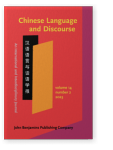Vol. 14:2 (2023) ► pp.209–231
Reconsidering the shi…(de) construction in spoken Mandarin
This paper revisits the use of the shi…de construction, based on the analysis of structures with predicative adjectives in a 500,000-character corpus of spoken Mandarin assembled from transcripts of a popular Chinese chat show. Overall, de was omitted more than 40% of the time with a predicative adjective, a significantly higher rate than that found in previous studies. The data reveal a number of factors that may all play a role in determining the likelihood of de omission or retention: the time dependency of the adjective, the particular intensifier chosen to modify the adjective, the discourse function of the utterance and the presence of certain markers of epistemic modality. The findings also lend support to the hypothesis that shi is grammaticalizing to a bound morpheme in some so-called ‘conventionalised forms’ involving epistemic and evidentiality markers.
Article outline
- 1.Introduction
- 2.Accounts of shi…de in the literature
- 3.Methodology and design
- 4.Research findings
- 4.1Patterns of shi…de with intensifiers
- 4.2Functions of shi…de
- 4.3Use of shi…de with different adjective classes
- 4.4Use of shi…de with epistemic markers
- 4.5Grammaticalisation of shi
- 5.Discussion and Conclusions
- 5.1Omission and retention of de in the shi…de construction
- 5.2Conventionalised forms / Grammaticalisation of shi
- 5.3Summary
- Notes
- List of abbreviations
-
References
